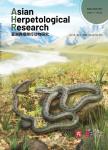Molecular Phylogeny Supports the Validity of Polypedates impresus Yang 2008
Molecular Phylogeny Supports the Validity of Polypedates impresus Yang 2008作者机构:School of Mining and Safety EngineeringYibin University College of Life SciencesSichuan University Kunming Institute of ZoologyChinese Academy of Sciences Chengdu Institute of BiologyChinese Academy of Sciences
出 版 物:《Asian Herpetological Research》 (亚洲两栖爬行动物研究(英文版))
年 卷 期:2013年第4卷第2期
页 面:124-133页
核心收录:
学科分类:0710[理学-生物学] 07[理学] 0905[农学-畜牧学] 09[农学] 071007[理学-遗传学] 090501[农学-动物遗传育种与繁殖]
基 金:supported by the program of Chinese Academy of Sciences (No. Y1C3011, No.Y1B3011, KSCX2EW-J-22) the National Natural Science Foundation of China (Grant No. 31101618)
主 题:Chinese Polypedates nucleotide sequence Polypedates leucomystax complex taxonomy
摘 要:The taxonomy of the Asian tree frogs of the Polypedates leucomystax complex, a group of widespread and morphologically similar species, is very controversial. To ascertain the taxonomic status of these species, we investi- gated the historical relationships among representative samples based on - 2 kb of nucleotide sequences from the mito- chondrial 12S rRNA, tRNAvalinc, and 16S rRNA genes. Our phylogeny resolved five well supported lineages (A, B, C, D and E) in the P leucomystax complex. Polypedates impresus from Yunnan, China, Polypedates cf. mutus and Polypedates cf. megacephalus from Guangxi and Yunnan, China, and Laos constructed Clade C, which is monophyletic. In order to recognize the unique position of this clade, we considered P impresus in Clade C as a valid species. Following our phy- logeny, Chinese Polypedates, corresponding to the other four clades, should include four species: P. mutus (Clade A); P. braueri (Clade B); P impresus (Clade C) and P. megacephalus (Clade D). P Ieucomystax (Clade E) is mainly distributed in the Malaysia, Indonesia and Philippines.



